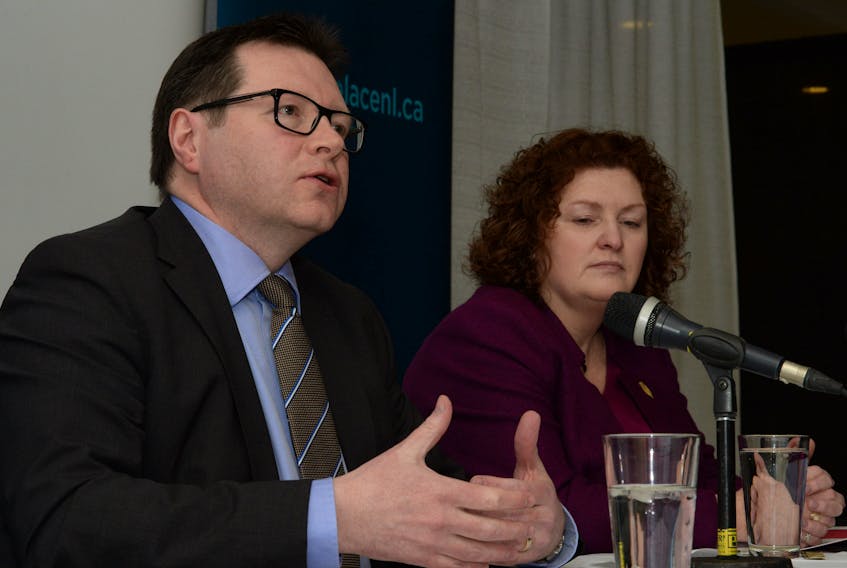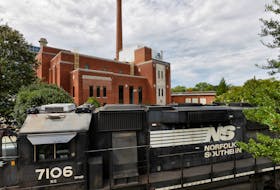The Liberal government wants to increase the compensation paid to injured workers in the province.
As ServiceNL Minister Sherry Gambin-Walsh announced Tuesday, at a joint news conference with WorkplaceNL, a bill will be introduced in the next session of the House of Assembly to amend the Workplace Health, Safety and Compensation Act. If approved, it would move the existing income replacement rate (IRR) — used in calculating worker benefits —from 80 per cent to 85 per cent.
“I myself, at one point in my life, was an injured worker, so I understand how difficult it is to be home and to try to adjust to the injury, accept the injury, and to try to get back to work,” she told reporters, saying the government has been listening when workers speak about the financial difficulties associated with a workplace injury.
An average of 14 people are injured on the job every day in Newfoundland and Labrador.
“I ask for the co-operation of all parties in the House of Assembly as we move forward,” she said.
Workers’ wage-loss benefits are calculated by starting with pre-injury, gross earnings — considered up to a cap ($64,375 for 2018). This is broken down to a weekly pay rate and, with that figure, Employment Insurance and Canada Pension Plan payments and probable taxes (provincial and federal) are deducted, leaving net earnings. The net amount is then multiplied by the IRR.
Each worker’s case is assessed individually, but anyone making about $39,000 gross pay today, before their injury, would expect about $1,600 more for the year if given the increase proposed, while a worker hitting the cap today could expect about $2,300 more with the change.
The government has committed to regulatory amendments to assure workers’ dependents would see the same change in benefits.
The increase in payments would be covered through the WorkplaceNL injury fund, funded at a rate of just over 126 per cent of claims, as of Dec. 31, 2016.
Injury claims have dropped in the province in recent years, reducing pressure on that fund. A new, five-year strategy from ServiceNL and WorkplaceNL — released at the same time as Gambin-Walsh’s announcement — aims to reduce injury rates further, and save more.
The change in claims has already led to a drop in the average assessment rate for employers. The latest move was Jan. 1, with the rate set at $1.90 per $100 of assessable payroll.
The proposed change to worker compensation would generally not require any increase in rates paid by employers, although self-insured employers such as Memorial University of Newfoundland would incur costs.
“Our concern is government needs to be very cautious about making announcements like this at a point when the economy is contracting, unemployment rate is going up. This will make the system more expensive and we fought very hard to bring that system under control over the last number of years,” said Richard Alexander, executive director of the Newfoundland and Labrador Employers’ Council.
The province has the third-highest worker compensation insurance premiums in the country, Alexander said.
The province covers more workers than any other (98 per cent versus 76 per cent in Nova Scotia, for example, he said) and has a higher duration period for workers being off work.
“With all due respect, workers gave up their right many decades ago to be able to sue their employer. They don’t go to work expecting to get injured and when they are injured, employers should step up to the plate and ensure they are protected,” said Newfoundland and Labrador Association of Public and Private Employees (NAPE) president Jerry Earle, also on hand for the announcement.
Mary Shortall, president of the Newfoundland and Labrador Federation of Labour, said the proposed change to the IRR was a recommendation from the 2013 required review of the act and has been requested for years.
“It was at 85 per cent a long time ago and it was the workers — at the same time the employers gave a $0.25 assessment (rate) increase, when the injury fund was struggling — workers went down to 80 per cent in order to help build that fund,” she said.
With the injury fund recovered, she said, it was time for workers to see some direct benefit, on balance.
“I’m delighted that government is finally taking action,” said NDP Leader Lorraine Michael, citing the same recommendation from the compensation review.
Michael said she would also like to see the removal of the cap applied in calculating benefits.
“We won’t stop the legislation because of that, but I’m going to make my concerns known,” she said.
The province is heading into another required review of the legislation.
Gambin-Walsh said the province is still receiving input and gathering information on the calls for changes applicable to workplace mental stress and post-traumatic stress disorder.









